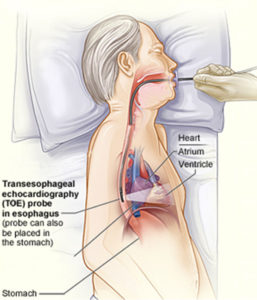
TOE (Transoesophageal Echocardiogram)
An echocardiogram (echo) uses inaudible sound waves to produce moving images of the heart. A Transoesophageal Echo (TOE) is where the ultrasound probe is positioned in oesophagus (feeding tube connecting mouth to the stomach) behind the heart from where high definition close up images of the heart can be obtained. The TOE test provides a close look at the heart’s valves and chambers, without interference from the ribs or lungs.
The ultrasound probe is mounted at the tip of a long thin flexible tube, which is guided down the patient’s throat into the oesophagus. The procedure is like gastroscopy performed by endoscopists.
TOE is only done in a hospital either under sedation and local anaesthesia or under general anaesthesia under the supervision of a qualified anaesthetist.
Why is this test performed?
TOE is often used when the results from standard echo tests are not sufficient, or when your doctor wants a closer look at your heart, especially the valves, to look for any hole in the heart, or to look for other problems like infections, growths and tumours, congenital heart disease etc. It is also very useful for prosthetic heart valve check-up. A TOE is also sometimes done before electrical cardioversion for any arrhythmias to rule out any blood clot in hidden parts of the heart.
Before the Procedure
- When this test is recommended, please tell your doctor if you have any problems with your oesophagus, such as a hiatus hernia, problems with swallowing, or any cancer.
- Please bring someone with you on the day of the test so that you can be driven back as you will not be allowed to drive yourself that day as the sedation given during the test makes it unsafe for you to drive after the test.
- DO NOT eat or drink anything for at least 5-6 hours before the test.
- Take all your medications at the usual times, as prescribed by your doctor. If it is within four hours of the test, please take your medications with only a small sip of water.
- If you have diabetes and take medications to manage your blood sugars, please contact your doctor for specific instructions about taking your medications before the test.
- Please do not bring valuables to the hospital.
- You may wear anything you like. You may change into a hospital gown before the test.
Procedure
- Before the test, a cardiologist (or another doctor) will explain the procedure in detail, including possible complications and side effects. You will have the opportunity to ask questions. You will be required to sign a consent form. Please make sure that you understand the procedure well including potential complications and have asked all questions before you sign the consent.
- The nurse / doctor will place three electrodes (small, flat, sticky patches) on your chest. The electrodes are attached to an electrocardiograph (ECG) monitor that charts your heart’s electrical activity.
- A blood pressure cuff will be placed on your arm to monitor your blood pressure.
- A small clip, attached to a pulse oximeter, will be placed on your finger to monitor the oxygen level of your blood.
- You will be given a spray in your mouth and a solution to gargle that will numb your throat.
- An intravenous access will be obtained which means placing a cannula in your vein to administer medications.
- The doctor will give sedation through this IV line to help you relax. You may feel drowsy.
- If a full general anaesthesia is being used, an anaesthetist will give you medications through the IV line.
- You will be asked to lie on your back on the bed.
- A plastic guard will be placed between your front teeth so that you cannot bite on the tube / ultrasound probe when the test is being performed.
- Your cardiologist will then insert a thin, lubricated endoscope into your mouth, down your throat and into your oesophagus. This part of the test lasts a few seconds and may be uncomfortable. The endoscope does not interfere with your breathing.
- Once the probe is in position, pictures of the heart are obtained at various angles (you will not feel this part of the test).
- Your heart rate, blood pressure and oxygen level of your blood will be closely monitored during and immediately after the exam.
- Because of the sedation, you may not be entirely awake during the test. We will keep you as comfortable as possible during the test. Tell the doctors if you feel uncomfortable at any time during the test. You may feel a temporary soreness or numbness in your throat after the test.
- The test may take from 30 – 90 minutes.
After the Procedure
- After you have recovered from the sedation given during the test and after the numbness in your throat is gone, you will be allowed to drink followed by eat. Start by drinking a cool liquid. If you don’t have any problems drinking cool liquids, you can eat and drink as you normally would. Nursing staff will help you in drinking followed by eating.
- Once you feel well after the procedure, you will discharge home.
- Remember, you cannot drive after the test.
Results
After the cardiologist has done the test and reviewed the images, the report will be written and sent to your referring physician and will be discuss with you as well.
Make a Booking Today.
Do not hesitate. Just talk to our freindly team.